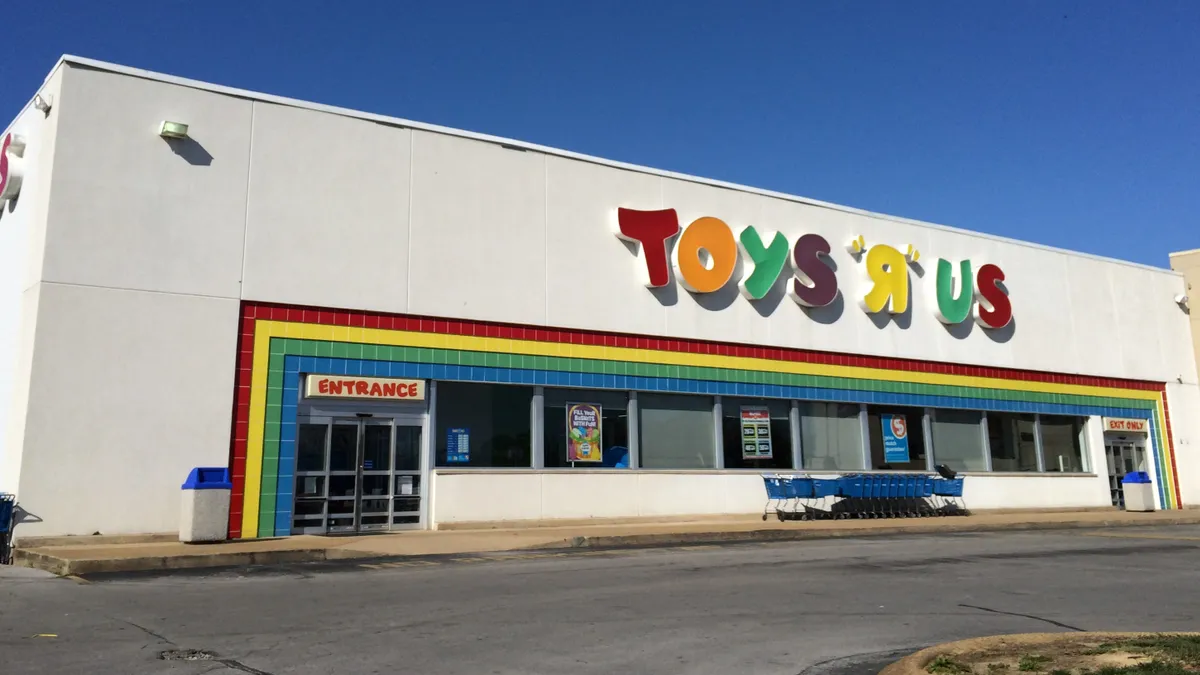Dive Brief:
- Toys R Us has come to a settlement agreement with some groups of creditors, including vendors, after what the retailer described as "months of intense, hard fought, arm's-length negotiations" that followed the company's move to liquidate in bankruptcy.
- In court papers filed this week, attorneys for Toys R Us said the settlement would resolve disputes that would otherwise "require protracted and expensive litigation." It would create a pot of funds for claims, including a baseline recovery of $180 million for participating creditors and then shared recovery after a group of secured lenders receive at least 50% of the $1 billion they're owed under pre-bankruptcy claims. Vendors and other creditors can opt out of the agreement.
- A group of vendors have said they are owed $800 million for merchandise shipped to Toys R Us. Several vendors, led by Crayola, objected to various aspects of the retailer's liquidation plan, saying in court papers that it prioritized certain lenders while leaving vendors who supported the company in bankruptcy with millions in unpaid-for merchandise.
Dive Insight:
The collapse of Toys R Us in bankruptcy was, put simply, a disaster for its suppliers. In the retailer, toy makers had an engaged partner in marketing their product that was dedicated to the sector year-round instead of just in the fourth quarter. Now, barring last-minute salvation, that partner is gone.
Losing Toys R Us leaves a $1.3 billion hole in the domestic toy market that suppliers are now scrambling to fill, though there are plenty of retailers who are jumping into the toy game in the wake of Toys R Us' fall.
But more immediately, the way that Toys R Us fell into liquidation left vendors with hundreds millions of dollars worth of orders unpaid.
In the early months of the company's Chapter 11 case, Toys R Us assured its vendors, customers and lenders that it would use the court process to restructure its business to be healthier and more competitive in the long term. That was a welcome message, after decades of cost and staffing cuts left the company — burdened with a multi-billion debt load from its private equity buyout last decade — ill-equipped to compete with mass merchants and Amazon.
But after an abysmal holiday season, the company missed key targets attached to its bankruptcy loan. Lenders refused to extend more cash to keep the company afloat through bankruptcy, ultimately forcing Toys R Us to wind down. All through that time, vendors had been shipping the retailer toy and infant products on credit. They could assume they were safe to do so, given Toys R Us' large debtor-in-possession loan.
In court papers filed this spring, Crayola, which is party to the settlement, alleged that Toys R Us accelerated product orders in January and February, at a time when company officials knew that they had essentially defaulted on their bankruptcy loan and could be forced to liquidate. The handicraft maker objected to several Toys R Us motions in court on the grounds that they hurt vendors and favored financiers of the retailer's bankruptcy loan.
Crayola's attorneys alleged earlier this year that Toys R Us was "well aware that their U.S. operations were already teetering on the precipice of failure" while accelerating their merchandise orders — conduct the attorneys described as "irresponsible and potentially illegal."
Toys R Us' settlement with creditors effectively heads off a protracted lawsuit over those and other allegations. Josh Friedman, a legal analyst with Debtwire, told Retail Dive that such settlements are how these disputes are typically resolved in bankruptcy. "It's rare to have full-blown litigation over this that culminates in a ruling from the court," Friedman said, adding that the legal costs of court battles provide incentive to settle.
While the settlement may resolve some of the legal fights, Toys R Us' suppliers, and others watching the drama play out, may not soon forget how badly they were bruised by the retailer's bankruptcy. The risk is that suppliers might hesitate, or even balk, at supporting retailers in Chapter 11 in the future.















